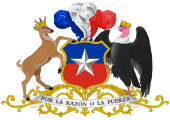1980 Chilean constitutional referendum

 |
|---|
| Comptroller General |
| Constitutional Court |
|
A constitutional referendum was held in Chile on 11 September 1980.[1] The proposed new constitution would replace the 1925 constitution, and was approved by over two-thirds of voters.[2]
The referendum was controversial, as Chile was then being ruled by a military dictatorship, and it ensured that Augusto Pinochet would remain in power with a rule by decree until 1988, after which he was peacefully removed from power following a popular referendum. Further reforms, beginning in 1989 and most recently in 2005, have attempted to make the constitution more democratic.[citation needed]
However, a referendum held in 2020 approved drafting up a new constitution after waves of popular protests.
Electoral system[]
In the election, Chileans older than 18 years of age (including the illiterate and blind), as well as foreigners with legal residence in Chile older than 18 years of age who could prove their proper immigration status, were allowed to vote. Participation was obligatory except for those who were physically or mentally impaired or imprisoned.
To vote, the only document required was a certificate of identity issued by the Civil and Identification Registry Service. No electoral roll was prepared for the referendum.[2]
New constitution[]
The proposed new constitution gave the position of President of the Republic significant powers. It created some new institutions, such as the Constitutional Tribunal and the controversial National Security Council (COSENA). In its temporary dispositions, the document ordered the transition from the former military government, with Augusto Pinochet as President of the Republic, and the Legislative Power of the Government Junta (formed by the heads of the Navy, Air Force, National Police, and a representative of the Army, the head of the Army being President of the Republic), to a civil one, with a time frame of eight years, during which the legislative power would still be the Military Junta. It set the first eight-year presidential term for Pinochet, with a referendum in the eighth year, in which only one candidate, nominated by the Junta, would be up for acceptance.
The candidate, as expected, was Pinochet himself. While the steps to follow in the case of a triumph of the "yes" option, which the document clearly anticipated, were clearly delineated, the steps for the "no" triumph were less clear but still clear enough that no serious doubt emerged when the "no" option actually was victorious in the 1988 plebiscite.
Some of the 1980 constitution's original provisions, such as the presidential power of dissolving the Chamber of Deputies (the lower house of Congress) and serving eight-year terms with possibility of re-election, were modified or eliminated after 1990, when the country regained its democracy and the Congress was re-established.
Results[]
The results supplied by the Colegio Escrutador Nacional (National Election Observer Association) were as follows.
| Option | Votes | %[3] |
|---|---|---|
| "Yes" votes | 4,121,067 | 65.71% |
| Blank votes | 83,812 | 1.33% |
| "Yes" total[4] | 4,204,879 | 67.04% |
| "No" votes | 1,893,420 | 30.19% |
| Invalid votes | 173,569 | 2.77% |
| Total votes cast | 6,271,868 | 100% |
Aftermath[]

The results of the referendum approved the Constitution of 1980. However, the given results were objected to by the political opposition, headed by the ex-senator Patricio Aylwin and more than 46 others, arguing that this result did not tally with electoral records. One objection was that voters were only marked by ink on the thumb, which came off rapidly, making electoral fraud easy. These criticisms were rejected by the Scrutiny Association, and the Constitution was promulgated on 21 October 1980.
The new constitution took effect on 11 March 1981. On this date a transition period of eight years began, during which General Pinochet, acting as President of the Republic and the Military Regime (Junta), exercised constituent and legislative power.
References[]
- Nazer A., Ricardo; Rosemblit B., Jaime (2000). "Electores, sufragio y democracia en Chile: una mirada histórica". Mapocho. Revista de Humanidades y Ciencias Sociales (48).
- Silva Bascuñán, Alejandro (1997). Tratado de Derecho Constitucional. Tomo III: La Constitución de 1980. Antecedentes y génesis. Santiago de Chile: Ed. Jurídica de Chile. ISBN 956-10-1178-6.
- Decree 3465 of August 8, 1980, Interior Ministry of Chile.
- Brief review of Chile's constitutional history - Chile's Library of Congress (in Spanish)
External links[]
| Spanish Wikisource has original text related to this article: |
- Official translation of the original 1980 Constitution Archived 2011-05-14 at the Wayback Machine (PDF file)
- Text of Chilean constitutions - Library of Congress of Chile (in Spanish)
- 1980 referendums
- Referendums in Chile
- Legal history of Chile
- 1980 in Chile
- Military dictatorship of Chile (1973–1990)
- Constitutional referendums in Chile
- September 1980 events in South America
